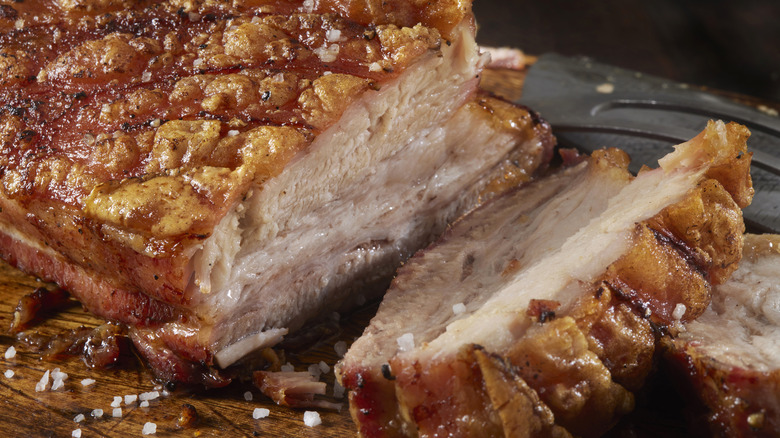The Temperature Trick For Crispy Skin On Slow-Roasted Pork Belly
If you eat meat, you've probably had pork belly many times in your life. That's because pork belly, when cured, smoked, and sliced, gives us bacon — that miracle food somehow both crisp and meltingly tender. Those same qualities are available to the home chef when preparing a boneless slab of pork belly at home; the succulence of slow-braising with a crackling crisp skin. The secret is the judicious use of high heat and knowing when to apply it.
Because it's so infused with fat and attendant self-basting qualities, people are tempted to overcook pork belly and end up with a hard and rubbery dinner. A great approach is to slow-roast the skin-on meat in a slow oven at 300 degrees Fahrenheit for a couple hours, depending on the size of the cut. Once the belly's internal temperature reaches 145 degrees Fahrenheit, the cooking is done. While slow roasting will leave you with a tender pork belly, it won't crisp up the skin. What's the solution?
Turn up the heat to ensure a crispy outer layer
Once the two hours have passed, this is the time to crank up the heat to 450 degrees Fahrenheit and give the pork belly another 20 to 30 minutes to crisp. If the roast has been salted correctly, the rind (or skin on top of the fat and meat) will render out, blister, and become crackling.
The four requirements for the perfect crispy pork skin are surface area, dryness, salt, and heat. Scoring the skin, which can be done by the butcher or when you get home, creates more surface area to absorb the salt. If you're serious about crackling, you can scald the skin by pouring boiling water over it before drying the meat and adding the rub, as it will curl the rind and further encourage the process.
Salt the belly generously (along with whatever other dry rub ingredients suit your fancy) and be sure to get the roast with very high heat to finish it off after cooking. The results will fully justify the effort: meltingly tender pork with a crispy exterior for the perfect bite.

